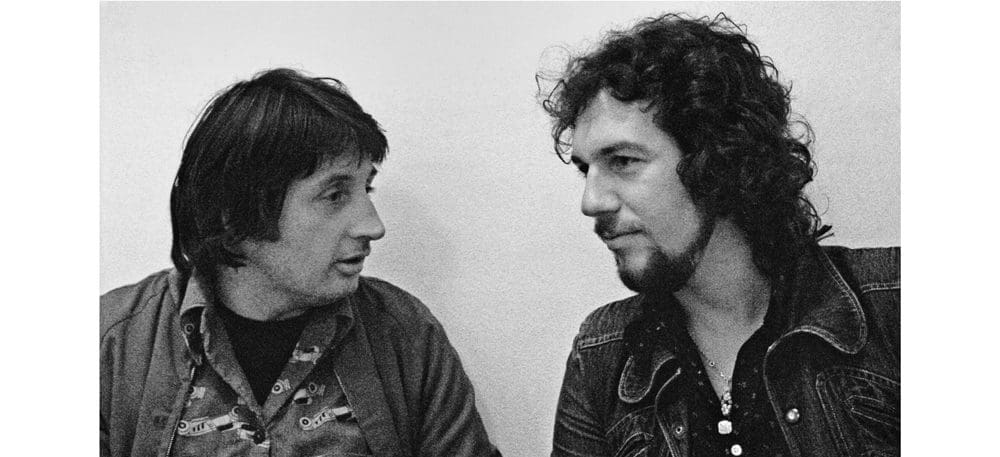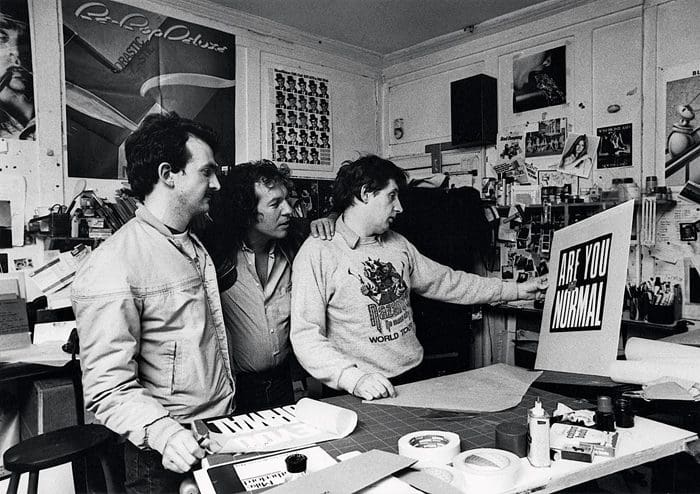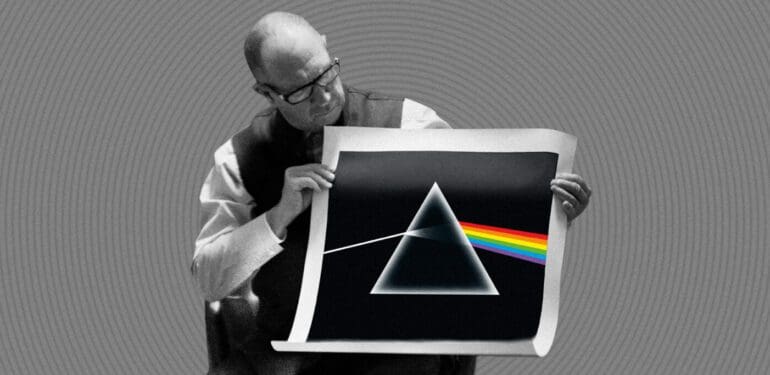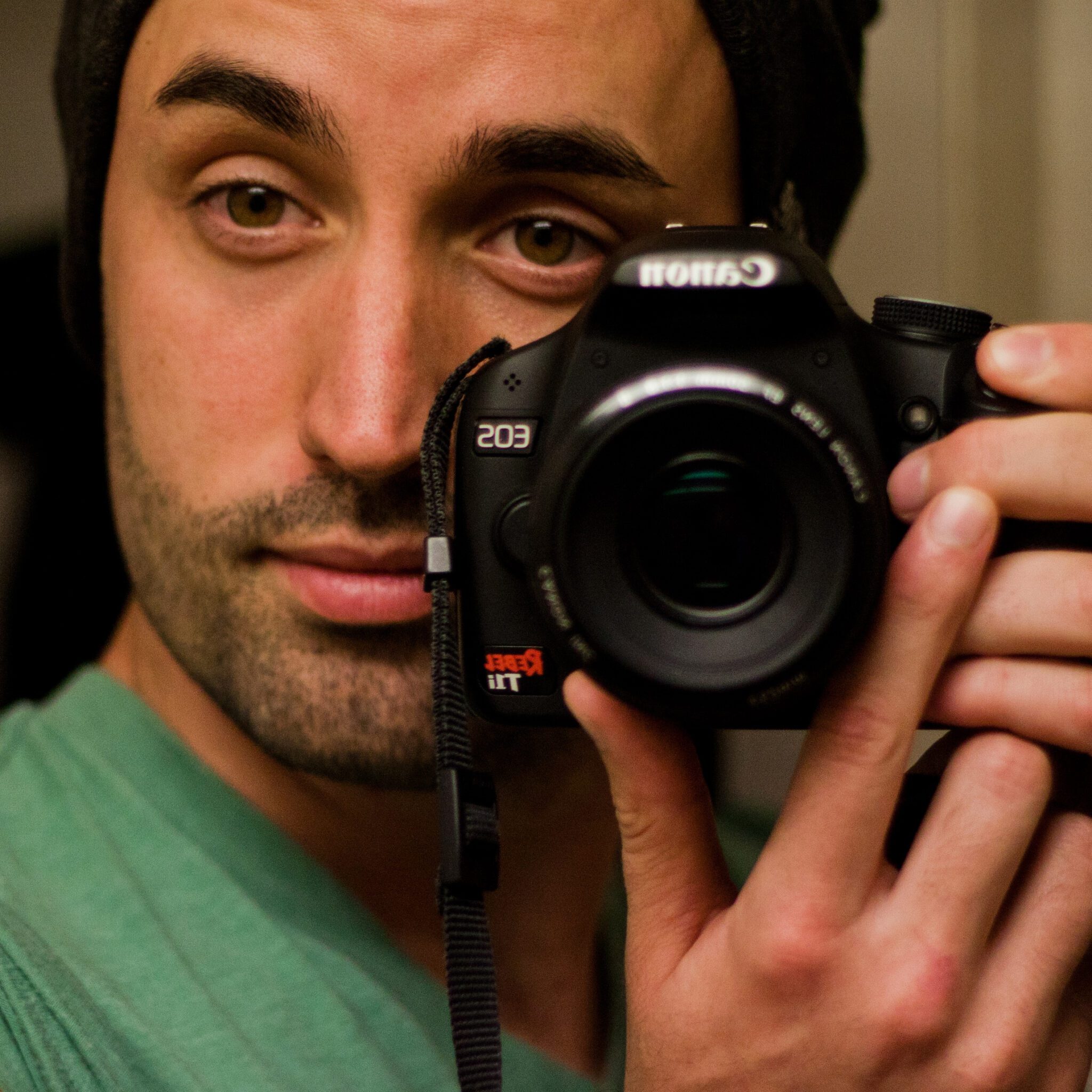Back in the late 1960s, British-born Aubrey “Po” Powell and childhood friend, the late Storm Thorgerson, founded Hipgnosis: a photo-design company that would change rock music forever. Responsible for such iconic designs as Pink Floyd‘s mysterious The Dark Side of the Moon, Led Zeppelin‘s paganistic Houses of the Holy, and AC/DC‘s censored everyday deviants with Dirty Deeds Done Dirt Cheap, both men flipped the script on what album art could be.
In the new documentary entitled Squaring the Circle (directed by Anton Corbijn), Powell candidly looks back on the history he made with Thorgerson, along with some very famous friends. ADDICTED’s Myles Herod had the rare opportunity to speak with Mr. Powell who unpacks the striking images he created for some of music’s most legendary acts, and why it mattered.
—
ADDICTED: Squaring the Circle (The Story of Hipgnosis) is quite the journey of your career. How did it personally feel to look back?
Aubrey: Pretty freaky. I have to say, very emotional, too. Because, although I was part of the filmmaking process as the narrator, I was not a part of making the film or related to the editing. So, it wasn’t until it was finished that I actually viewed the thing in its entirety and I found it a deeply emotional and shocking experience. To have a film made in your own lifetime, to remind you of yourself and your work, is a pretty extraordinary thing to do.
The surviving members of both Pink Floyd and Led Zeppelin appear prominently in the film. Were you surprised by that?
Aubrey: No, because I’m friendly with all of them still 50 years on. I’m very friendly with Robert [Plant], Jimmy [Page], David [Gilmour], Nick Mason, and Roger Waters. We worked with Pink Floyd everyday because I was the creative director. I remember phoning up Jimmy and saying, “We’re making a film and we’d like you to be in it. It’s Anton Corbijn directing, it’s about Hipgnosis and Led Zeppelin.” He responded, “Those three? Of course I’ll be in it. This is a celebration for all of us.” And that was the response from Paul McCartney and everybody else. And you know what was fantastic about that? It was the fact that they were so gracious about appearing in the film, and funny, too.
What made Anton Corbijn the right choice to tell your story?
Aubrey: They presented me with a couple directors who I didn’t particularly like. Then I said, “There’s only one person for me. It’s Anton Corbijn. I don’t know him. I’ve never met him. But I’m a huge fan of his work.” He appeared on the scene about 10 years after Hipgnosis started. But he had experience doing album covers. He had experience doing photography. He had experience in filmmaking. He was a person I greatly respected for his work with U2 and Depeche Mode. And I loved his film Control.
So I flew to Amsterdam and I met with him. The first half of the meeting he was very cool about it. He hadn’t made a documentary before. I think he was anxious about that. He then went off to make a phone call and when he came back he said, “You know what, I’ll do it.” That was it. He’s made the most incredible legacy for Hipgnosis. It’s a very truthful and accurate portrait.
Together as Hipgnosis, you and Storm Thorgerson came up with a disproportionate amount of great, iconic album covers. What made your relationship so creative and fertile?
Aubrey: Storm and I both had different roles to play in the company. When we started we were the best of friends. We were inseparable because we had the same goal. The second thing was that he was very good at thinking of ideas that were really out of the box. Total natural thinking. The unexpected. He would often rely on dreams that he had. He was very burdened with his dreams. Every day he’d have dreams and sometimes he’d come in and say, “Ah, I’ve seen these red balls in the desert. I don’t know what it’s for or what it means. I’m sure we can use it somewhere.”
But I was the photographer. I was very good at photography. Storm taught me photography, but he wasn’t that competent himself. Before Hipgnosis I’d been working at the BBC as a set designer in television. I also ran the business. Storm had no idea about money whatsoever. Absolutely hadn’t a clue. It’s a bit like any relationship, like Liam and Noel Gallagher, Lennon and McCartney, or Mick and Keith – it’s almost essential to have a duo to bounce off each other to come up with the best results.

Hipgnosis co-founders Storm Thorgerson and Aubrey “Po” Powell
Did you notice a change after the massive success of Dark Side of the Moon and Zeppelin’s House of the Holy?
Aubrey: Yes, after 1973, Dark Side of the Moon started selling like hotcakes with five million in the end and we suddenly became the go-to studio for everybody in rock and roll. However, for the first five years we were very much hand to mouth. We were very amateur. By the time Hipgnosis first got their studio, we had to borrow money from our parents to pay for the rent. The studio was a dump. It really was. It was full of old film lights, darkroom equipment, this, that, and the other.
London was not a great place to be either. There was a lot of impoverishment. And we were just a part of that at the time. And we struggled. I would do anything. Honestly, I would shoot for girlie magazines. I would shoot bar mitzvahs. Just to make money, learn my trade, and bring in money for the studio. Slowly, slowly, slowly over those first five years from 1968 to 1973 things moved ahead. And then when we finally hit 1973, that year was the tipping point. After that we were approached by all kinds of people. And not just in music either. We had requests from the movie industry. But I think, at that point, our reputation had got to be so good that we were actually deluged by work. It was hard to keep up. We were working 14 hours a day, seven days a week to keep going, ya know? And money was coming in, which was very helpful.
There’s a part in the documentary where Roger Waters of Pink Floyd recalls the moment when you and Storm came in with a few design ideas for The Dark Side of the Moon and the band chose one right away. How typical was it for a group to decide on a cover so resolutely?
Aubrey: Funny enough, bands came to Hipgnosis with what Hipgnosis could offer. Whether it was Led Zeppelin or Wishbone Ash or Black Sabbath or you know, Paul McCartney. Whoever it was, they wanted us because we offered something different. Once you get a reputation from working with the biggest bands in the world, everybody wants a piece of you. And they assume what you’re going to give them is great. And it wasn’t always so. Some of the album covers we did weren’t so good. But many were.
Bands never came to us and said, “Oh, I’ve got an idea.” And if they did, we didn’t want to do it. Rarely did bands get involved. For example, with Led Zeppelin, we always went to them with ideas. Not necessarily any title or music or lyrics. Just ideas. And they liked them. And they were brave enough to have them. I mean, who would have, for a heavy rock band, a black object sitting on a supper table with a family sitting around it like we did on their Presence album? (laughs) I mean, this is not heavy rock. The symbol of the black object was a heavy image, though. This was something that everybody needed. Without that, you couldn’t live. So, likewise, without Led Zeppelin, you couldn’t live. There was definitely a symbolic, intellectual thinking behind it. And I think that’s what appealed to people.
Who are some bands of that era that you wanted to work with but never did?
Aubrey: There were two. I wanted to work with The Doors. And I wanted to work with Bob Dylan. We never put out feelers to anybody to work with them. We always felt, well, they’d come to us, if they can. And sadly neither of those acts ever came to us. Never happened. But I would’ve loved to have worked with those two.
What are some of your favourite designs that aren’t as iconic as say the heavy hitters like Zeppelin or Pink Floyd?
Aubrey: One of the most important ones, which was in the film and another turning point for us, was the red footballs in the Sahara Desert for The Nice. An album called Elegy. That was one of the few times, in the early years, when a rock artist – Keith Emerson, who was the leader of The Nice – stood up and said, “I want this, I’m having this.” That was a tipping point for us because we realized that you could do a piece of land art and make that into an album cover. That’s one of my absolute favourites.
I think the second favourite, probably less well-known, is Black Sabbath’s Technical Ecstasy. I absolutely love that album cover. It’s a love affair between robots on an escalator. And again, what’s that got to do with Black Sabbath? Well, they called the album Technical Ecstasy so that was our version of it. (laughs) Another is AC/DC’s Dirty Deeds Done Dirt Cheap, which was the first album cover they ever had done. I remember these two little tiny Australian guys coming in, skinny as anything, saying, “We want a nice album cover, we don’t know what it is, but it’s called Dirty Deeds Done Dirt Cheap.” I just so happened to be in LA so I shot a scuzzy motel on the Sunset Strip and photographed all those characters who appear on the front in a studio and then collaged it altogether. It’s kinda got that voyeuristic, rather dark undercurrent of sordid sexual deeds, I suppose. Nefarious deeds, let’s call it that, within the picture. Although you actually don’t see anything. It’s a cover I’m very fond of.

At the Hipgnosis studio: (left to right) Peter Christopherson, Aubrey “Po” Powell, and Storm Thorgerson.
You didn’t take on very many American acts it seems. Primarily just British ones. Is that a misconception on my part?
Aubrey: Not necessarily true. We worked with Hall & Oates, we worked with Styx, and one or two other American acts. Predominantly though, because we were an English studio I think the convenience was there for British bands to come in. That was another thing about the Hipgnosis studio, we became a meeting point. Where we were situated was Denmark Street, where everybody used to buy their guitars, amplifiers, and everything like that. So suddenly, you know, you’d find Peter Gabriel coming up the stairs. And then there’d be John Wetton from King Crimson and Asia popping in. Musicians would drop in and chat. It became a meeting point for people because they had nowhere else to go. And sometimes, it was chaos. You’d be trying to do a photograph or something in the studio and a bunch of rockers would turn up. (laughs) But it all added to the fun and games. It was wonderful.
It’s been said that Storm preferred to call Hipgnosis an “art house” and not a “design company”…
Aubrey: I’d agree with him. I’d also add it was reminiscent of Andy Warhol’s Factory because everybody in the studio by the mid-70s, there were probably 20 people working up there. Graphic designers, people in the darkroom, assistants, other photographers, all sorts of people there that we trusted. It was an art house, and you know, it had a fantastic atmosphere almost like an art school studio. Everybody was doing their thing. I made the comparison with Warhol’s Factory because his studio was full of people doing different things. It wasn’t just him. He’d say, “Ok, this is what I wanna do.” But then you’d have someone who’d do the silkscreen printing, someone would be drying them, somebody would be working out the graphics, somebody else taking film. It was very much like that. We were exactly the same. We were an art house. That’s what I would call Hipgnosis.
Are you proud so many of your images are going to live on, well, forever?
Aubrey: Now in my 77th year, Hipgnosis’s images are as popular now, if not more so, than they were in the 1970s. I’m incredibly privileged that the images live on, like Dark Side of the Moon for example, and incredibly proud. And to be honest, slightly overwhelmed by it in a way.
With all you’ve seen and done in life, what do you know for sure?
Aubrey: I’ll tell you what I know. It’s what I tell students when I give lectures. If you believe in what you’re doing, work hard. Put in 12 hours a day. Put in seven days a week. Don’t be slack. Don’t live at home with your parents. Get on with it. Because nobody else is going to hand it to you on a plate. And if you work hard at what you believe in, you’ll get there. And there’s no question. A lot of people who worked for Hipgnosis as assistants, editors, all those roles, they all went on to be successful because of the regime Storm and I ran, which was, “If you don’t work hard, you’re out.”


